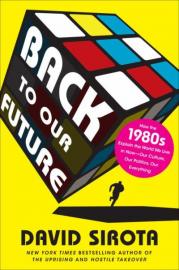By Robert Relihan, Senior Vice President
Last week, I saw David Sirota discuss his book, Back to Our Future: How the 1980s Explains the World We Live in Now - Our Culture, Our Politics, Our Everything. His thesis is that, beginning in the ‘80s, American society has become increasingly focused on the individual. He, of course, used words such as “narcissism” to describe this. One piece of evidence he offered was that the number of people who were members of a civic organization had almost halved over a 15 year period beginning in the early ‘90s. 
Well, we have heard this all before; it’s the “Bowling Alone” argument.
But, as I listened this time, my first reaction, probably influenced by all of the online research C+R has been conducting of late, was to think, “Hey, wait a minute. What about all of those online communities and social networks? Aren’t communities both growing and proliferating? Isn’t there lots of interaction among the members of these communities? Hasn’t our ‘social capital’ merely moved online? Isn’t the tendency of people to select their own affinity groups a replacement for traditional communities?”
The answer is yes and no. It is important for marketers to keep in mind the differences between online communities and physical communities when they plan their strategies and conduct their research.
- Online communities are not physical; they do not have locations. This observation may be in the category of “Duh.” But, what does the difference mean? We conduct surveys that use a “nationally representative sample.” That sample reflects general population distribution. Perhaps, it is more important to reflect the density of different self-selected communities. A traditional qualitative project might be conducted in different markets to achieve a “national representation.” Might it be better to be in a single market, but reflect different communities — evangelical Christians, environmentalist, and the like — in separate focus groups? And, most obviously, if online communities are the way people are organizing themselves, shouldn’t we really be talking to consumers online?
- Online communities are more homogeneous. Members of online communities consciously select themselves. They seek members with whom they share beliefs and interests. And, if that is the case, do my samples of members of these online communities need to be as large as a sample of a physical community?
- Online communities are more fragile, less stable. Recent news suggests that Facebook traffic is declining. There are a number of ways to interpret this data, but the trend highlights the fact that people enter and leave online communities with much greater frequency than they enter and leave physical communities. I might have confidence in the results I obtained from a well-designed survey of my town for three years. But, if I were to rely on a survey of an online community, I might want to revisit my results in half that time.
Online communities are the new reality. They are indeed a rich, focused source of information. But, a changed world requires changed methods and perspectives, and C+R is prepared to guide you through this new territory.









